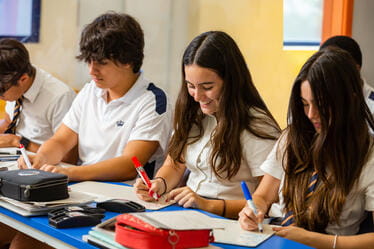We use cookies to improve your online experiences. To learn more and choose your cookies options, please refer to our cookie policy.


During the first 2 weeks back to school, starting a new academic year, we wanted to hear our students' voices and learn about their perspectives with regards to language learning. We used the Language Portrayals because each person has a particular connection to the language(s) they know along with their lives. What would that look like to our pupils? Is there a preference for any language? Which one do they prefer talking about? Or writing? Or listening to music?
At BCB, more specifically in Secondary school, our pupils have the experience of learning at least 2, if not 3 languages at the same time. After some time teaching here, I realised that terminologies such as first language, second language, or mother tongue might not be wide enough to explain how each child perceives the language(s) they have contact with during their time here, due to the fact that their life experiences are diverse. For instance, if a child has learned one language from one parent and the other from the other parent, simultaneously, what would define the first language for this person? Is it necessary to define a "first language"? Are both "first languages"? How much does someone have to know of a language to be bilingual? Is there a mother tongue?
If in the past, Bloomfield, a North American linguist, defined bilingualism as “native-like control of two languages (1933:56)", now bilingualism is defined by Hammers and Blanc (2000) as a spectrum that involves aspects of life experiences that take place in communication such as context, register, formality, informality, purpose, written and spoken language, people involved on communication, time of contact with the language, who they have learned them from, intermediate (or not) by electronic devices, immediate or not immediate responses, emotional connections, the topic of conversation, etc. According to these researchers, there are 15 types of bilingualism. And if bilingualism can be so diverse, multilingualism is even more varied!
My own inquiries as a teacher also led me to dialogues with my colleague language teachers in order to think about strategies that enable us to learn more about our pupils while promoting self-awareness for them, making thinking visible and leading them to reflect on how they can learn languages better.
For this reason, we used the Language Portrayals, created by Brigitta Busch, an Austrian-Swiss linguist researcher. The Language Portrayals basically consists of students outlining a human body and, with their own colour codes, represent the language/s they know, in freestyle, placing the language/s in a part of the body they feel that would represent their connection with it/ them. In the end, they were supposed to briefly write about the drawing, thinking about who, when, and why they use the languages for. As we predicted, using the Language Portrayals, each one had a particular thing to say about their experiences with these languages, as well as the ones they have learned before coming to school. This is something I expected, but what really impressed me was their emotional connections. We know this is a fact, but hearing it from the students was amazing.
Here in Brazil, the Language Portrayals have been used by many language teachers alongside linguist researchers in order to understand the diverse contexts that can be found and conclude that this is not a monolingual, but a multilingual country, with more than 200 hundred live languages and 2 official ones, português and LIBRAS (Brazilian sign language).
Apart from that, 19 cities around the country have português and one more co-official language. Acknowledging this diversity means promoting equality and access to education, health care, housing, valorization of cultures, values, and voices.
In conclusion, this was a very rewarding experience and I hope our students have the chance to reflect on their language experiences during this academic year.
See some of our Language Portrayals below!
Letícia, Y7A
Ana Laura, Y7A
Eunsung, Y8A
Uxue, Y8B
Ranvir, Y9B
Chaeeun (Anna), Y9C
Caroline, Y10B
Irem, Y10B
Valentina, Y11A
Hilda, Y11A
Keosha, Y12